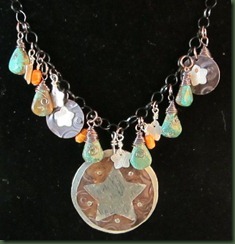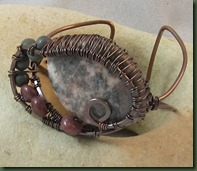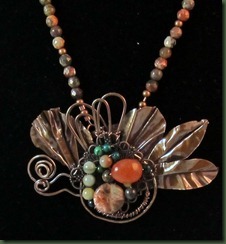A prior post discussed bead soup and displayed photos of the lovely mixture of beads and findings that I received from Laura Demoya, http://www.thebeadtherapist.blogspot.com/
Each of us involved in the bead soup event were given a specific date to reveal what we designed with the soup that we received. Today is my day.
When I received the bead soup, I was intrigued by the little purple ceramic bird shown. It made me think about the little critters that pass by my window as I work. This bird was made by Pajego Art House http://www.etsy.com/shop/PajegoArtHouse?ref=seller_info and was intended as a clasp. I decided to use it as a main embellishment in the necklace rather than as it was intended. The round pendant in the center is from White Clover Kiln http://www.etsy.com/shop/WhiteCloverKiln?ref=shop_sugg .
Before telling you more about the necklace, I’d like you to know more about the birds outside my window. The large window in my studio provides a hazard for some of the birds here at the ranch. They fly under the front porch roof and crash their little heads into the window. As my cat has grown older and become a bit slower in catching the birds from her tree perch, she has learned that if she is patient and sits on the outside window sill, a bird may crash into the window and become stunned long enough for her to capture it. I’ve tried to tell her that this is cheating, but she just doesn’t get it. It often seems to me that the birds go round and round in uneven circles as they try to figure out whether or not they can fly right into my studio.
The aforementioned tale explains the conception of the shape of the copper wire armature as well as the name of the necklace. I freeform manipulated the wire to go around as the birds sometimes do in flight.
It seemed obvious to me that the ceramic bird should be wired onto the armature. Yet, this little bird had different ideas. Each time I secured it with wire, I then held up the piece and the little bird turned upside down. I tried various wire gauges, said both nice and then harsh words to the inanimate object, but to no avail. He still hung upside down. Then I spotted the ribbon Laura sent in the soup. After I wrapped this around the back of the bird several times, he finally stayed in place. (Notice this bird became a “he” bird when I started having trouble with it.)
The rest of this piece needs little explanation as it was simply embellished with the beads as I wired them into place. It was a very pleasant process after I finally secured that bird right side up. The handmade chain in the back also sports bead links and a handmade clasp. The wire armature and handmade chain were dipped in Liver of Sulphur and then went for a couple of hours ride in the tumbler. At the same time, I dipped and tumbled the light gauge wire that I used for attaching the embellishments.
This was enjoyable to make and Laura afforded me the opportunity to work with ceramic pieces from another designer as well as to use crystals which I seldom work with. I used the other beads and sterling silver clasp in the other necklace shown below. The amethyst drusy focal for this piece is from Magpie Gemstones (www.magpiegemstones.com) Thanks to Lori Anderson for her grand organization of the bead soup project and for letting me participate.
As for flying in circles . . . I fear I do a good bit of that inside my studio and I really should slow down and relax more before I end up just as confused as some of those poor outside fliers!
Numerous other designers are revealing their bad soup pieces today. You will find their addresses at the following http://lorianderson-beadsoupblogparty.blogspot.com/2012/06/participants-of-6th-bead-soup-blog.html .

























